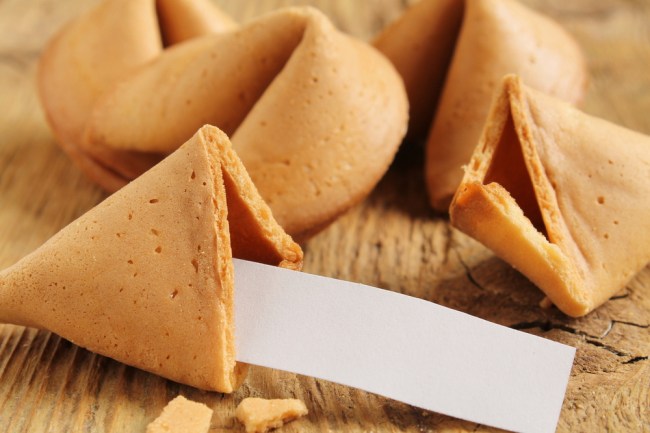
Shutterstock
You may have believed that the fortune cookie has a history that goes back hundreds of years and was born in China, but neither of those assumptions are true. In fact, the fortune cookie was actually created in the United States by a Japanese immigrant.
According to the Smithsonian Institute, Suyeichi Okamura is the inventor of the tasty treat packed full of prophecies. Suyeichi came to the U.S. and started Benkyodo, a Japanese confectionery store in San Francisco, in 1906. Suyeichi brought with him the recipe for a Japanese cookie that resembled the modern-day fortune cookie that dates back as far as the 19th century and was popular in Kyoto, Japan. They called the random fortunes “omikuji,” and the Japanese cookies were larger, contained sesame and miso. Suyeichu made his cookies smaller and lighter in color than the original ones from Japan and used vanilla and butter instead of sesame and miso.
Suyeichi sold his fortune cookies to Makoto Hagiwara, a man who ran the Japanese Tea Garden at the Golden Gate Park. Suyeichi engraved the initials “M.H.” for “Makoto Hagiwara” and even put the Tea Garden’s logo into the fortune cookies. The cookies were known as “fortune tea cakes” up until around World War II. The belief among many is that when over 100,000 Japanese-Americans were sent to internment camps during World War II, the vacant fortune tea cake business was taken over by Chinese immigrants who made the confection their own. They then provided fortune cookies at Chinese restaurants as a sweet treat for Americans who expected dessert.
Suyeichi made his fortune cookies with a hand skillet mold and hand-folded the dough after inserting the small paper fortunes. Some places still fill and fold their fortune cookies by hand such as The Golden Gate Fortune Cookie Factory, in San Francisco’s Chinatown.
Meanwhile, others use fully automated machines to make up to four million fortune cookies a day. The dough consists of flour, sugar, vegetable shortening, water, food coloring, and starch as a thickener. The cookie mix is blended and pumped into a patty-shape mold on hot moving trays. The dough is compressed and cooked for about a minute in an oven. A machine inserts the small paper fortunes into each one of the cookies, and then quickly folded to seal the fortune inside. They are then wrapped in plastic and sent to your local Chinese restaurant so you can eat a sweet treat and get to see how good or bad your future will be.